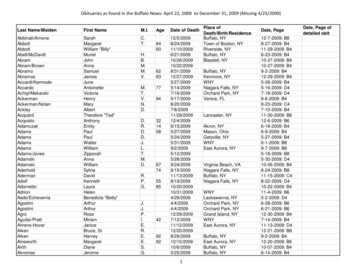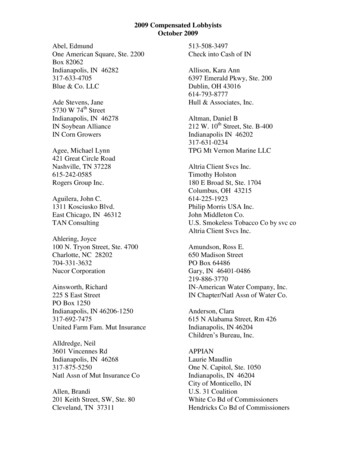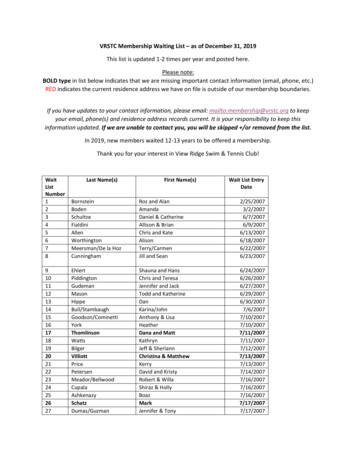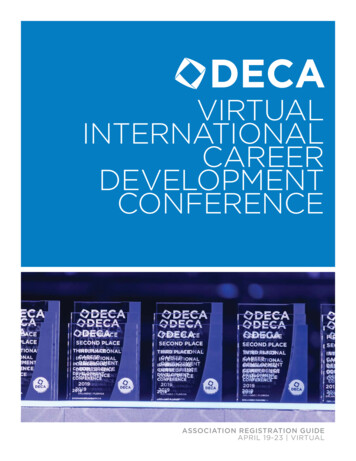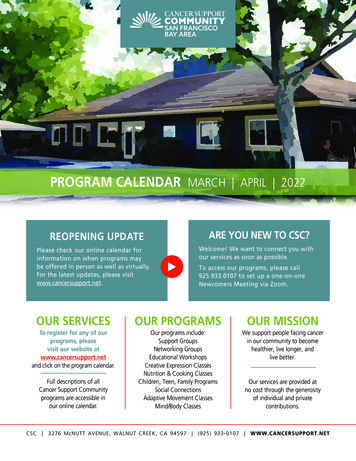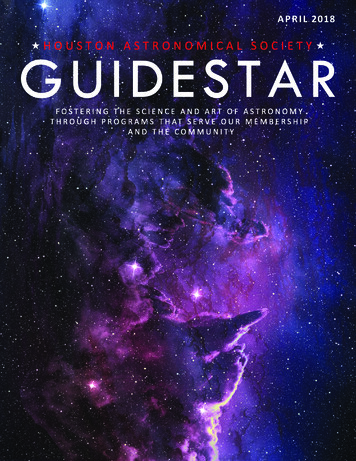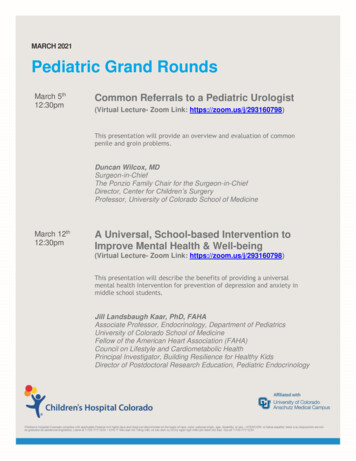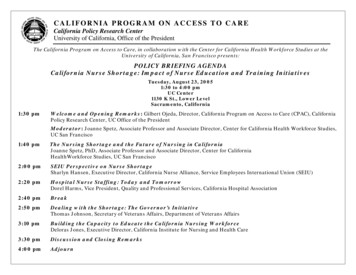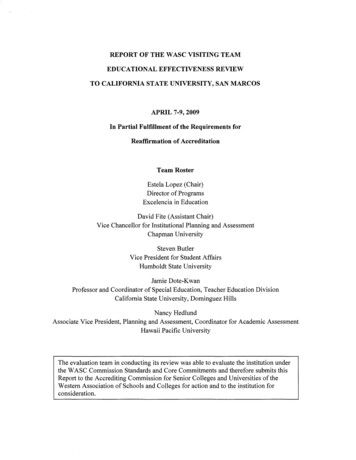
Transcription
REPORT OF THE WASC VISITING TEAMEDUCATIONAL EFFECTIVENESS REVIEWTO CALIFORNIA STATE UNIVERSITY, SAN MARCOSAPRIL 7-9,2009In Partial Fulfillment of the Requirements forReaffirmation of AccreditationTeam RosterEstela Lopez (Chair)Director of ProgramsExcelencia in EducationDavid Fite (Assistant Chair)Vice Chancellor for Institutional Planning and AssessmentChapman UniversitySteven ButlerVice President for Student AffairsHumboldt State UniversityJamie Dote-KwanProfessor and Coordinator of Special Education, Teacher Education DivisionCalifornia State University, Dominguez HillsNancy HedlundAssociate Vice President, Planning and Assessment, Coordinator for Academic AssessmentHawaii Pacific UniversityThe evaluation team in conducting its review was able to evaluate the institution underthe WASC Commission Standards and Core Commitments and therefore submits thisReport to the Accrediting Commission for Senior Colleges and Universities of theWestern Association of Schools and Colleges for action and to the institution forconsideration.
SECTION I- OVERVIEW AND CONTEXTA.Description of Institution and Visit . 1B.The Institution's Educational Effectiveness Review Report: Alignment with theProposal and Quality and Rigor of the Review and Report .2C.Response to Issues Raised in the Capacity and Preparatory Review .4SECTION II- EVALUATION OF EDUCATIONAL EFFECTIVENESS UNDERTHE STANDARDSA.Evaluation of the Institution's Educational Effectiveness Inquiry .9Reflective Essay 1: Academic Master Planning .9Reflective Essay 2: Strengthening Academic Programs through Assessment ofStudent Learning . 13Reflective Essay 3: Improving Retention of First-Year Students . 18B.Institution's Systems for Enhancing Educational Effectiveness and StudentLearning.26C.Student Success .26D.Program Review .28SECTION III- SUMMARY, MAJOR FINDINGS, AND RECOMMENDATIONSA.Institution's Fulfillment of Intended Outcomes for the Review .32B.Value and Effectiveness of the Review .34C.Major Recommendations from both CPR and EER.36APPENDIXReport on Accelerated BS in Nursing Program, Temecula .39
SECTION I- OVERVIEW AND CONTEXTA. Description of Institution and VisitCal State San Marcos was founded in 1989 as the 20th campus of the public California StateUniversity. CSU San Marcos began as a branch of San Diego State University and evolved intoan independent campus to meet expanding regional enrollment needs. The campus has grownfrom 280 full-time equivalent students (FTEs) in 1990 to become a medium-size campus with anenrollment of approximately 7,435 FTEs and 9,159 headcount in the Fall 2007. A significantproportion of its students are adult students and/or first-generation college students. CSU SanMarcos is largely a commuter school but committed to expanding its residential population. TheUniversity in its Institutional Self-Study Proposal of May 2005 observes that it "is now at acritical juncture in its history, needing to move from its core set of liberal arts and sciences,business, and education programs to become a comprehensive regional university."CSU San Marcos was granted initial accreditation by the WASC Commission in June 1993.Following a WASC site visit in March 2000, the WASC Commission reaffirmed theaccreditation of CSU San Marcos in June 2000 and scheduled the Capacity & PreparatoryReview for its next Self-Study for Re-accreditation in the Spring 2007.In February 2005 theWASC Commission approved the Substantive Change Proposal for a Doctorate in EducationalLeadership (EdD) to be offered jointly by the University of California, San Diego, San DiegoState University, and California State University, San Marcos. Following a WASC Capacity &Preparatory Review site visit in March 2007, the WASC Commission acted to continue theaccreditation of CSU San Marcos in June 2007 and scheduled the Educational EffectivenessReview in Spring 2009.The Commission requested that CSU San Marcos incorporate itsresponse to the issues raised in the WASC action letter and the major recommendations of the1
W ASC CPR Team Report in its Educational Effectiveness Review Report. The Commissionalso noted that the W ASC CPR team reviewed the progress of the Doctorate in EducationalLeadership (EdD) offered jointly by the University of California, San Diego, and California StateUniversity, San Marcos, following the withdrawal of San Diego State University from the jointprogram, and that the Team found that the program was operating effectively and the Universityhad addressed the issues raised by the WASC Commission in its approval action. In August2008 the W ASC Commission approved the Substantive Change Proposal of CSU San Marcosfor an accelerated BS in Nursing Program (blended). A report on the accelerated BS in NursingProgram offered in Temecula is included in the Appendix of this Team Report.B.The Institution's Educational Effectiveness Review Report:Alignment with theProposal and Quality and Rigor of the Review and ReportCSU San Marcos has taken a thematic approach to the Educational Effectiveness Review,organizing its report around the three themes of academic master planning, strengtheningacademic programs through assessment of student learning, and improving retention of first-yearstudents. The University's Educational Effectiveness Review Report is generally consistent withthe themes and plans presented in its Institutional Proposal. In cases where CSU San Marcos hasdiverged from its Proposal, the Educational Effectiveness Review Report clearly explains thereasons for doing so, most notably in Reflective Essay One on Academic Master Planning wherea new focus on three-year rolling plans, a division-wide academic strategic plan, a forecastingprocess, and a new comprehensive process aligning academic planning and budget has replacedthe Institutional Proposal's focus on the role of the Academic Blueprint in guiding theUniversity's academic master planning.The Educational Effectiveness Review Report is2
clearly written and demonstrates rigorous mqmry with sound questions, appropriatemethodologies, and generally effective use of evidence.The essays of the EducationalEffectiveness Report do not present references to WASC standards and criteria for review butCSU San Marcos provided a separate (if somewhat incomplete) "CFR-to-Essay Bridge" at therequest of the Site Visit Team.CSU San Marcos is a young institution that has moved from rapid institutional growth to aperiod in which it is forced by economic challenges to level enrollments and face possible budgetreductions while maintaining a vibrant academic environment and sustaining commitments to adiverse student body and outreach to local communities. The Educational Effectiveness Reviewprocess and report has enabled the University to reflect on, renew, and revitalize its efforts in theareas of academic planning, assessment for improvement of academic programs, and retentionand achievement of first-year students.The Introduction to the Educational EffectivenessReview report cites "four points" which "anchor" the University's Educational Effectivenessapproach:1. clearly articulated student learning outcomes for undergraduate and graduateprograms; 2. faculty-led program review processes; 3. disaggregated student data illustratingthe achievement levels of students; 4. collaboration between Academic Affairs and StudentAffairs on persistent student issues (p. 1). The University has made progress in increasing itsorganizational capacity to learn despite the challenges it faces in implementing an academicmaster planning process and effective program review process. (See the discussion of ProgramReview in Section II D of this Team Report.)3
Following the CSU San Marcos Capacity and Preparatory Review site visit in Spring 2007,campus teams of faculty, staff, and administrators were convened in Fall 2007 to examine andwrite about the three themes of the Educational Effectiveness Review. These teams refined theirtask and revised certain outcomes of the original Institutional Proposal, consulted withappropriate stakeholder groups and used institutional data sources, and produced draft essays thatwere shared with the campus community, including the Academic Senate and its committees,through a website and five university Town Hall meetings. The self-study process demonstratessignificant campus participation and engagement and institutional commitment to the creation ofa "learning organization" based on an emerging "culture of evidence" and key functions such asplanning, assessment, and program review that the University continues to develop andstrengthen.C. Response to Issues Raised in the Capacity and Preparatory ReviewCSU San Marcos in its Educational Effectiveness Review Report presents a generally thoroughresponse to issues highlighted by the WASC Commission in its action letter of July 13, 2007receiving the Capacity and Preparatory Review Team Report and continuing the accreditation ofthe University. WASC highlighted three issues in its action letter: 1. student access and success;2. curricular and co-curricular assessment of learning; 3. enhanced budgetary planning.TheWASC Commission also asked the Site Visit Team during its visit to evaluate the effectivenessand progress of the accelerated BS in Nursing Program (blended) implemented by CSU SanMarcos following WASC Commission approval in August 2008.4
Student Access and SuccessThe WASC Commission in 2007 recognized that CSU San Marcos had made systemiccommitments to the concepts and culture of diversity (CFR 1.5) and recommended that theUniversity ensure appropriate support for diversity leadership in order to solidify and enhancethese commitments. The WASC Commission also recommended that the University conductdisaggregated reviews of retention and completion rates, begin to track completion rates fordifferent student groups, and, using this data, begin to set targets in areas where improvement isneeded. CSU San Marcos addresses these recommendations in Reflective Essay 3: ImprovingRetention of First-Year Students in its Educational Effectiveness Review Report and in thedisaggregated data on graduation rates provided in the WASCIACSCU Summary Data Form.The University has made substantial progress in conducting disaggregated reviews of retentionand completion rates for different student groups and using this data to make improvements inacademic support programs and services and in student retention and achievement, especially inthe first year. For analysis of the University's efforts and progress in improving student accessand success, see the discussion of Reflective Essay 3 on Improving Retention of First-YearStudents in Section II A and Student Success in Section II C of this Team Report.The University continues to make progress toward its strategic priority of diversity and hassought to provide appropriate support for diversity leadership in a number of ways (CFR 1.5).The Educational Equity Task Force appointed in 2005-06 was allowed to sunset and in its placethe President named a Special Assistant to the President for Educational Equity and Diversity.This position will continue until funds are available to support a full-time position. The5
President's office is also funding the Social Justice and Equity Project, which is engaging facultyin conversations to foster a multicultural, global teaching and learning environment.Following a recommendation made by the Educational Equity Task Force regarding the need forformal data gathering, a campus climate survey will be conducted this spring. Data gatheringwill enable the University to benchmark and measure progress on diversity-related initiatives.The President also held two diversity forums around the topics of student retention, faculty andstaff recruitment, retention and mentoring, and campus climate. Through these discussions,several action goals have been identified and will be used to develop next steps.CSU San Marcos remains on track in its goal to become an HSI (Hispanic Serving Institution)and has appointed an Implementation Team to work toward that goal. The University hopes tobecome a recognized Hispanic Serving Institution by the year 2010, having reached thequalifying threshold of25% Latino student enrollment in the Spring 2009.Curricular and Co-Curricular Assessment ofLearningThe W ASC Commission in 2007 observed that CSU San Marcos had made noteworthy progressin incorporating student learning outcomes into most of its academic programs and in planningfor related assessment activities, but needed to incorporate direct assessment of learning morefully into all of its academic and co-curricular programs.The W ASC Commissionrecommended that the University continue to develop ways to assess the impact of its co curricular programs on the formation of its graduates (CFR 2.1 0) and observed that the use ofachievement data to inform program improvement should achieve a higher degree of consistency6
among the various units of the University (CFR 4.7, 4.8). The Commission also noted thatsupport for curricular and co-curricular assessment of learning could serve as a focus of ongoingfaculty and staff development. CSU San Marcos addresses these recommendations in ReflectiveEssay 2 on Strengthening Academic Programs through Assessment of Student Learning of itsEducational Effectiveness Review Report and in the accompanying Inventory of EducationalEffectiveness Indicators.The University has made substantial but uneven progress inincorporating direct assessment of learning more fully into all of its academic and co-curricularprograms. CSU San Marcos has assessed student writing and information literacy in 19 differentcourses engaging 50 faculty members and approved a Graduate Studies Writing AssessmentRequirement Policy.The University has published student learning outcomes for allundergraduate programs and most graduate programs in the 2008-10 Catalog, and implementedan annual plan for assessment activities to be completed by all degree programs. Direct evidenceof student learning and progress has been collected either at the course or program level byselected programs in all three Colleges, the School of Nursing, and Student Affairs.Mostprograms that have results are just beginning to make decisions for improvement and implementthose decisions (CFR 1.2, 2.2-2.6, 4.6, 4.7).At the same time, the University could not sustain a planned multi-year research study of studentwriting at several points in their academic progress or an institutional e-portfolio initiative. Inaddition, the implementation of a program review process incorporating learning outcomesassessment has been delayed by faculty resistance and concerns over the relation betweenprogram review and planning and decision-making processes and the need for institutional andbudgetary support for faculty work on assessment and program review and for alignment of7
retention, tenure, and promotion policies with an increased emphasis on assessment in teachingand instruction. CSU San Marcos has provided faculty and staff development and other supportfor assessment through the appointments of a Learning Outcomes Assessment Fellow andGeneral Education Assessment Coordinator, provision of funds for developing programassessment activities, and support for learning outcomes assessment projects in Student Affairs(CFR 2.8-2.10, 3.4. For analysis ofthe University's efforts and progress in improving curricularand co-curricular assessment of learning, see the discussion of Reflective Essay 2 in Section IIA, the Institution's Systems for Enhancing Educational Effectiveness and Student Learning inSection II B, and Program Review in Section II D of this Team Report.Enhanced Budgetary PlanningThe WASC Commission in 2007 observed that the budget planning process of CSU San Marcoswas quite inclusive and transparent but could benefit from more extensive use of data on theeffectiveness of its current allocations.The WASC Commission recommended that theUniversity consider obtaining and using benchmark comparisons from similar institutions fromwithin and beyond the CSU system (CFR 3.5, 4.8). CSU San Marcos has substantially revisedits academic, master planning, and budgetary processes in the past two years with the goal ofachieving an enhanced budgetary and planning process which promotes transparency, strategicthinking, and use of evidence when allocating resources. This includes creating an AcademicAffairs Strategic Plan to unify planning directions, developing three-year rolling plans for allunits in Academic Affairs, establishing a University Academic Master Plan ForecastingCommittee to review and use university, community college, high school, regional, statewide,national, and global data in planning and decision-making processes, and more clearly aligning8
budgetary and planning processes. For analysis of the University's efforts and progress inenhancing budgetary planning, see the discussion of Reflective Essay One on Academic MasterPlanning in Section II A of this Team Report.SECTION II- EVALUATION OF EDUCATIONAL EFFECTIVENESS UNDER THESTANDARDSA. Evaluation of the Institution's Educational Effectiveness InquiryReflective Essay One: Academic Master PlanningFounded in 1989, CSU San Marcos is still a relatively young institution. Offering academicprograms that prepare students to serve the region is of one of the highest priorities for theinstitution. Thus, planning and managing programmatic growth has been a consistent theme inthe development of the institution as well as in the self-study process. This theme was identifiedin the Institutional Proposal to WASC in 2005, in the Capacity and Preparatory Review, and nowin the Educational Effectiveness Review.Reflective Essay One of the CSU San MarcosEducational Effectiveness Report is dedicated to analyzing the changes that have occurred inguiding the academic planning processes since the proposal was submitted (CFR 3.5, 4.1-4.6).As the University continues its path to becoming a regional comprehensive institution, academicplanning is a critical component, especially in times of scarce resources. CSU San Marcosapproached academic growth in the early part of the decade with what it referred to as "a wellresearched and conceived Academic Blueprint to respond to rapid population growth and studentand community/employer demand" (Institutional Proposal, p. 1)9
Since 2003, using the Academic Blueprint process, the University was able to start ten newprograms, eight at the bachelor's level, one at the master's level, and a doctorate in EducationalLeadership. Five of the bachelor's degrees were in sciences or health areas. Five of the tenprograms have exceeded enrollment projections. In addition, another four programs are in finaldevelopment and implementation stages. Currently, the University offers 27 bachelor's degreeprograms, ten master's degree programs, five teaching credentials, four advanced credentials,and one doctoral degree program.As is evident, there has been significant programmatic growth in the last few years.Nevertheless, as Reflective Essay One describes, "over the years, those involved with programplanning have identified several gaps or shortcomings in the process" (p. 5).The analysis ofthese gaps and the campus response to them are at the core of this reflective essay (CFR 4.1,4.4).The campus acknowledges that there was confusion regarding the relationship between theUniversity Master Plan and the Academic Blueprint and among the roles of various stakeholders.In addition, there was also a disconnect between the program approval and budgeting processes.In reflecting on these issues, the Provost decided in 2006-07 to "sunset the Academic BlueprintCommittee and to begin exploring options for building upon the Blueprint's strengths, whilecorrecting some of its weaknesses" (p. 6). In its place, four interrelated activities have beenidentified and are at different stages of development: unit three-year rolling plans, a division wide strategic plan, a forecasting process, and a new comprehensive process aligning academicplanning and budget (CFR 3.5, 4.1-4.6).10
To better link budget and planning, all units of Academic Affairs are expected to produce three year rolling plans (CFR 4.1-4.4). These plans should connect planning assumptions andprogrammatic initiatives to resource allocation requests. As Reflective Essay One states, thethree-year rolling plans serve as a "means of laying out" the goals of the academic units and"making transparent the costs associated with their own growth and development" (p. 7).Academic Affairs is in the process of completing its strategic plan. During the first phase,vision, mission, core values, and goals for the division were defined.The second phase,scheduled to begin in Spring 2009, will address the development of objectives by each of thetwelve units. These objectives should then become part of the units' three-year rolling plans.The University Academic Master Plan Forecasting Committee (UAMPFC) is a new initiativethat continues some of the activities of the Academic Blueprint Committee.It includesrepresentatives from all units of Academic Affairs, the Academic Senate, and other divisions(CFR 4.1-4.5). As a "think tank," the UAMPFC does not recommend or make decisions, butsimply "scans the environment for information that can inform planning efforts" (p. 8). Thisgroup held its first meeting in the Spring Semester 2009.To develop a transparent budget process, the University Budget Committee began reviewing thebudget cycle and processes with the expectation that in Spring 2009 it would propose a revisedUniversity budget development process for implementation in 2010-11. One of the goals of therevised budget process is increased understanding by different stakeholders of the revenues and11
expenditures dimensions of the budget. Academic Affairs has also revised its budget approachand has now created "an 18-month planning calendar that takes into account the budget andacademic program planning cycles" and integrates the three-year rolling plans (p. 8).Thiscritical integration will address the cost of program development and sustaining and expandingcurrent program offerings (CFR 4.1-4.5).These activities of academic master planning at CSU San Marcos are still a work in progress anddepend on the University's ability to fully develop them and ensure their integration andcoherence. Reflective Essay One demonstrates the campus's ability to question and search forbetter approaches to align planning and budgeting.CSU San Marcos has honestly identified the challenges it faces as the University implements thenew activities (CFR 3.5, 4.1-4.6). These challenges include: Developing concrete acasJemic objectives in support of campus goals Testing and improving planning tools Cultivating the knowledge and supporting the leadership of campus constituencies Assessing whether or not the academic master plan meets specific goalsThe Team presents the following recommendations: The activities that have been identified as integral components of planning need to befully developed and implemented, including unit three-year rolling plans, the academicstrategic plan, a data-based forecasting process, and resource allocation (CFR 3.5, 4.1 4.6).12
The University should continue to seek innovative approaches to academic planning andprogram development, such as the use of Extended Learning for program developmentduring the current time of budgetary challenges, to offer programs that serve the needs ofthe students and the region (CFR 4.1-4.3, 4.8).Reflective Essay 2: Strengthening Academic Programs through Assessment of StudentLearningReflective Essay 2 focuses on the following four researchable outcomes: Improved understanding, grounded in evidence, of students' performance in the keycommon learning theme of writing Data showing the evolution and publication of student learning outcomes for each major Attention to the quality of student learning in periodic program review reports and annualassessment progress reports Use of assessment findings at the course or program level in order to improve studentlearning1. Improved understanding, grounded in evidence, ofstudents' performance in the key commonlearning theme ofstudent writingIn the 2006-07 academic year, the appointment of a General Education Assessment Coordinatorprovided the focus for the systematic study of two key General Education (GE) learningoutcomes, written communication and information literacy. Four different areas of GE--WrittenCommunication, Critical Thinking, Mathematics/Quantitative Reasoning, and Social Sciences- have participated in the assessment effort. Faculty assess their students' writing using a standard13
rubric and receive individual feedback while aggregated scores are sent to the department chairwithout faculty names. The GE Committee has established a large database of student writingand concluded that the majority of the students in the GE courses surveyed met "a minimumstandard for all SLOs for written communication (thesis, organization, and mechanics) andinformation literacy (finding information and using information)" (p. 11). CSU San Marcos willuse these preliminary results to revise the current GE program in accordance with the new CSUChancellor's Office Executive Order 1033, which requires GE to be aligned with the Associationof American Colleges and Universities' LEAP (Liberal Education and America's Promise)Initiative. CSU San Marcos has made significant progress in GE assessment, including directassessment of student performance and engagement of faculty. It is unclear if changes have yetoccurred in GE resulting from these assessment efforts. The University has extended the writingoutcome beyond GE into the majors and at the graduate level, as evidenced by the AcademicSenate's approval of a Graduate Studies Writing Assessment Requirement Policy, which requiresgraduate programs to assess whether their students have met graduate-level writing competencybefore advancing to candidacy (CFR 2.2-2.6).2. Data showing the evolution and publication ofstudent learning outcomes for each majorAll undergraduate and most graduate programs have published student learning outcomes(SLOs) in the University's 2008-10 Catalog and most of the SLOs are available on theassessment website (CFR 2.4). Learning outcome matrices have been requested of programsundergoing five-year program review. Three methods for reinforcing SLOs as part of the campusculture (CFR 2.3) include the template for proposing new programs, the University CurriculumCommittee's requirement that all new course proposals need to specify SLOs, and the annual14
assessment report's requirement that programs assess two specific SLOs and specify "what wasmeasured, and how, and how faculty will apply the results of assessment at the program andcourse level for continuous improvement" (p. 15) (CFR 2.2-2.6, 4.6, 4.7).3. Attention to the quality of student learning in periodic program review reports and annualassessment progress reportsPlease see the discussion of Program Review in Section II D of this Team Report.4.Use of assessment findings at the course or program level in order to improve studentlearningSeveral examples from three colleges-Arts and Sciences, Business Administration, andEducation--are presented in the Educational Effectiveness Review Report to illustrate the use ofdirect evidence of student learning to support learning at the course or program level. Most of theexamples clearly illustrate the quality of the evidence of student learning (i.e., analyzing studentpapers, using pre-test/post-test design, and developing rubrics for assessing oral presentation)and the findings from the assessments. There has been significant progress in this area; whereasonly 9 of 28 departments submitted annual assessment information in the 2005-06 academicyear, over 75% of the programs did so in the 2007-08 academic year. These reports requireprograms to assess two SLOs either at the course or program level. Most programs are reportingresults from this assessment process, but are just beginning to make decisions for improvementand implementing these decisions. An example is the Communication Department, which useddata collected from an in-class exercise on students' comprehension of "standpoint" andimplemented a change wherein faculty placed more emphasis on discussing the concept of15
standpoint. Preliminary results suggest this change has improved the desired student learningoutcome (CFR 4.6, 4.7).Review ofthe University's Inventory of Education Effectiveness Indicators (Fall2008) indicatesthat all programs have identified the data/evidence used to determine that graduates haveachieved stated outcomes for the degree beyond GPA. But many programs, when queried, "Howare findings used?," stated, "Continuous program improvement depending on conclusions fromdata analysis" rather than providing specific changes or improvements that have occurred. It isalso unclear whether targets or benchmarks for improvement have been established.In the Division of Student Affairs, co-curricular assessment of learning initially started withestablishing SLOs based on the Council for the Advancement of Standards in Higher Education(CAS), but was later
Report on Accelerated BS in Nursing Program, . Cal State San Marcos was founded in 1989 as the 20th campus of the public California State University. CSU San Marcos began as a branch of San Diego State University and evolved into an independent campus to meet expanding regional enrollment needs. The campus has grown
